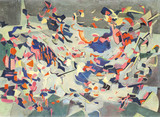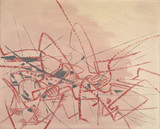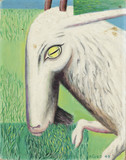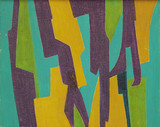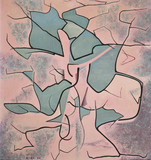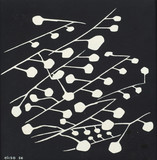Statuesque, with purple hair and a knack for comedy, Elise (as she was known) first came to the public attention as a comic actress, partner to W. C. Fields. After studying art at the Pennsylvania Academy of the Fine Arts in Philadelphia and dancing abroad, she entered the new field of films, settling eventually in Los Angeles; her most famous credit was The Dentist (1932). In California she met and married the music impresario Merle Armitage. Armitage was also a collector of prints and a modernist book designer, and it was probably through him that she returned to the visual arts, working with noted printmaker Lynton Kistler on her first prints in 1932. By 1933 she had turned to abstraction and soon became one of the few non-objective artists in Southern California. In the late 1930s she gave up acting, exhibiting the oil painting Out of Space at the 1939 New York World’s Fair. She continued painting and drawing throughout the 1940s until her death. Increasingly responding to current movements in a very personal way by expanding the size of her canvases, she preferred a bold palette, slashing brushwork, and emphasized linear elements, which had always been essential to her aesthetics. She exhibited primarily in California and in the 1950s helped found with Helen Lundeberg and Lorser Feitelson the group Functionalists West.
The estate of James Welton, Elise’s last husband, generously donated paintings, drawings, and textile designs to the Los Angeles County Museum of Art in 2008. Added to the prints, earlier gifts of Armitage and others, LACMA now has the most complete collection of works by this little-known but significant early modernist. The present group of works documented here is the beginning of the cataloguing process of this large gift. Other works will be added to this site periodically and documentation updated as research continues on Elise.
Bibliography
Armitage, Merle, and Louis Danz. Elise, By Merle Armitage; an Article by Louis Danz; and a Portrait by Beatrice Wood. New York: E. Weyhe, 1934.



